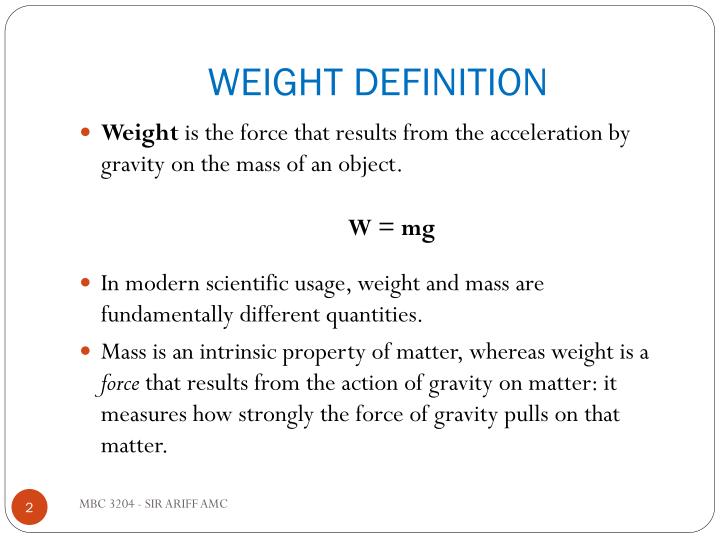

The inertia and the inertial mass describe this property of physical bodies at the qualitative and quantitative level respectively. The mass of an object determines its acceleration in the presence of an applied force.

This is because weight is a force, while mass is the property that (along with gravity) determines the strength of this force. An object on the Moon would weigh less than it does on Earth because of the lower gravity, but it would still have the same mass.

In physics, mass is not the same as weight, even though mass is often determined by measuring the object's weight using a spring scale, rather than balance scale comparing it directly with known masses. The SI base unit of mass is the kilogram (kg). The object's mass also determines the strength of its gravitational attraction to other bodies. Mass can be experimentally defined as a measure of the body's inertia, meaning the resistance to acceleration (change of velocity) when a net force is applied. Mass in modern physics has multiple definitions which are conceptually distinct, but physically equivalent. It was found that different atoms and different elementary particles, theoretically with the same amount of matter, have nonetheless different masses. It was traditionally believed to be related to the quantity of matter in a physical body, until the discovery of the atom and particle physics. Also, learn the two theorems such as parallel axes and perpendicular theorem explained with respect to rotational motion of objects.Mass is an intrinsic property of a body. The axis of the rotation usually goes through the body. The force applied here is called the torque. When a force is applied on a body about an axis it causes a rotational motion. A body moves completely in rotational motion when each particle of the body moves in a circle about a single line. In this portion, we will learn about the rotational motion of the objects. (x) The position of centre of mass of an object changes in translatory motion but remains unchanged in rotatory motion. (ix) In symmetrical bodies having homogeneous distribution of mass the centre of mass coincides with the geometrical centre of the body. (viii) The centre of mass of an object need not to lie with in the object. (vii) The position of centre of mass depends upon the shape, size and distribution of the mass of the body. It means, isolated system will remain at rest if it is initially at rest or will move with a same velocity, if it is in motion initially. (vi) Centre of mass of an isolated system has a constant velocity. (i) Then, position of centre of mass from m 1 = \(\frac\) If a system consists of n particles of masses m 1, m 2, m 3,…,m n having position vectors r 1, r 2, r 3,…, r n then position vector of centre of mass of the system.Ĭhoosing O as origin of the coordinate axis., Centre of Mass in Physics | Definition, Examples, Formulas – Rotational Motion We are giving a detailed and clear sheet on all Physics Notes that are very useful to understand the Basic Physics Concepts. whether it is in rest or in accelerated motion centre of mass will remain same. For rigid bodies, centre of mass is independent of the state of the body, i.e.

Centre of mass of a system is the point that behaves as whole mass of the system is concentrated on it and all external forces are acting on it.


 0 kommentar(er)
0 kommentar(er)
